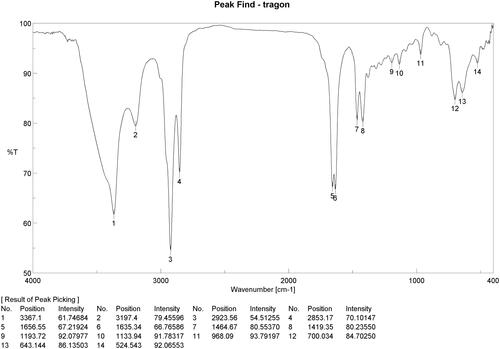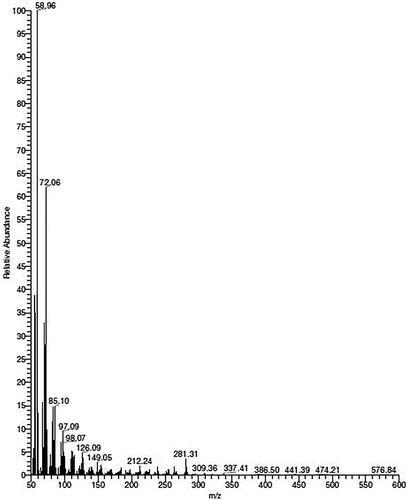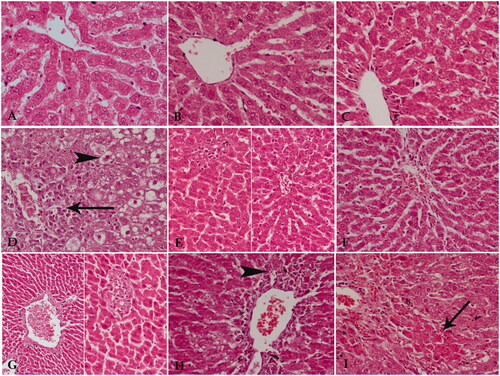Figures & data
Figure 1. The chemical composition of Tagetes lucida roots extract as analysed by the HPLC. *mAU means a milli-absorbance unit or 0.001 absorbance units that are used to measure absorbance.

Figure 2. Identification of corynan-17-ol, 18,19-didehydro-10-methoxy-, acetate (ester), the major component of Tagetes lucida root extract; IR. *Y axis; T% means transition percentage, X axis; was wavenumber band (cm−1).

Figure 3. Identification of corynan-17-ol, 18,19-didehydro-10-methoxy-, acetate (ester), the major component of Tagetes lucida root extract; MS. m/z means mass/charge.

Figure 4. Identification of corynan-17-ol, 18,19-didehydro-10-methoxy-, acetate (ester), the major component of Tagetes lucida root extract. Corynan-17-ol, 18,19-didehydro-10-methoxy-, acetate (ester) 17-(acetyloxy)-18,19-didehydro-10-methoxycorynan CAS NO: 56053-13-5. Molecular Formula: C22H28N2O3 and Molecular Weight: 368.46932. m/z means mass/charge.

Table 1. The therapeutic and protective effect of Tagetes lucida root extract on total body weight gain (g) and relative weight of liver (%), CYP2E1 activity, and TNF-α content.
Table 2. Effect of Tagetes lucida root extract on liver functions of CCl4-induced hepatotoxicity in rats.
Table 3. Effect of Tagetes lucida root extract on oxidative stress biomarkers and antioxidant biomarkers.
Table 4. The effect of Tagetes lucida roots alcoholic extract in lipid profile of liver.
Figure 5. A photomicrograph of liver tissue sections from A) Liver of the negative control rats showed the normal structure of this tissue. B) Livers of positive control of silymarin showed normal structure but with slightly dilated blood sinusoids. C) Livers of positive control of Tagetes lucida root extract showed quite normal architecture of liver tissue. D) Livers of therapeutic control showed a significant distortion of the general architecture of the tissue, necrotic cells around the central veins (arrow), and vacuolar degeneration of many cells at the periphery of the lobules (arrowhead). E) Livers of silymarin-treated therapeutic rats showed a marked amelioration of liver tissue except for small focal areas of necrotic cells and/or dilated blood sinusoids. F) Livers of Tagetes lucida root extract-treated therapeutic rats showed liver tissue close to normal but with few inflammatory cells around central veins. G) Livers of the protective control rats showed dilatation and congestion of main blood vessels with fibrosis. The parenchyma of liver tissue shows a focal aggregation of necrotic cells. H) Livers of silymarin-treated protective rats showed inflammatory and necrotic cells around dilated central veins (arrowhead). I) Livers of Tagetes lucida root extract-treated protective rats showed mild protective effect as areas of acidophilic degenerated cells were observed (arrowhead). Hx & E × 400.

